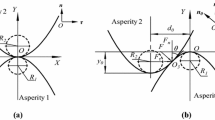Abstract
The paper describes a general computational model for the simulation of contact fatigue-damage initiation in the contact area of meshing gears. The model considers the continuum mechanics approach, where the use of homogenous and elastic material is assumed. The stress field in the contact area and the relationship between the cyclic contact loading conditions and observed contact points on the tooth flank are simulated with moving Hertzian contact pressure in the framework of the finite element method analysis. An equivalent model of Hertzian contact between two cylinders is used for evaluating contact conditions at the major point of contact of meshing gears. For the purpose of fatigue-damage analysis, the model, which is used for prediction of the number of loading cycles required for initial fatigue damage to appear, is based on the Coffin-Manson relationship between deformations and loading cycles. On the basis of computational results, and with consideration of some particular geometrical and material parameters, the initiation life of contacting spur gears in regard to contact fatigue damage can be estimated.
Similar content being viewed by others
References
ANSI/AGMA, American National Standards (2001) Appearance of gear teeth: terminology of wear and failure. ANSI/AGMA 2001-B58, AGMA, Alexandria, VA
Aberšek B, Flašker J, Glodež S (2004) Review of mathematical and experimental models for determination of service life of gears. Eng Fract Mech (http://www.sciencedirect.com), Eng Frach Mech 71(4–6):439–453
Benedetti M, Fontanari V, Höhn BR, Oster P, Tobie T (2002) Influence of shot peening on bending tooth fatigue limit of case hardened gears. Int J Fatigue 24:1127–1136
Bhattacharya B, Ellingwood B (1998) Continuum damage mechanics analysis of fatigue crack initiation. Int J Fatigue 20(9):631–639
Cheng W, Cheng HS, Mura T, Keer LM (1994) Micromechanics modeling of crack initiation under contact fatigue. J Tribol Trans ASME 116:2–48
DIN 3990 (1987) Calculation of load capacity of cylindrical gears. German standard, Beuth, Berlin
Dudley DW (1996) Fatigue and life prediction of gears. Fatigue Strength Predict Analys 19:345–354
Dudley DW (1994) Handbook of practical gear design. Lancaster, Basel
Ekberg A, Bjarnehed H, Lunden R (1995) A fatigue life model for general rolling contact with application to wheel/rail damage. Fatigue Fract Eng Mater Struct 18(10):1189–1199
Flašker J, Fajdiga G, Glodež S, Hellen TK (2001) Numerical simulation of surface pitting due to contact loading. Int J Fatigue 23:599–605
Fatemi A, Yang L (1998) Cumulative fatigue damage and life prediction theories: a survey of the state of the art for homogeneous materials. Int J Fatigue 20(1):9–34
Glodež S, Aberšek B, Flašker J, Ren Z (2003) Evaluation of the service life of gears in regard to surface pitting. Eng Fract Mech (http://www.sciencedirect.com), Eng Frach Mech 71(4–6):429–438
Glodež S, Šraml M, Kramberger J (2002) A computational model for determination of service life of gears. Int J Fatigue 24:1013–1020
Glodež S, Flašker J, Ren Z (1997) A new model for the numerical determination of pitting resistance of gear teeth flanks. Fatigue Fract Eng Mater Struct 20(1):71–83
Glodež S, Ren Z, Flašker J (1998) Simulation of surface pitting due to contact lodging. Int J Numer Methods Eng 43(1):33–50
Glodež S, Ren Z, Flašker J (1999) Surface fatigue of gear teeth flanks. Comput Struct 73:475–483
Glodež S, Ren Z, Fajdiga G (2001) Computational modelling of the surface fatigue crack growth on gear teeth flanks. Commun Numer Methods Eng 17(8):529–541
Haiba M, Barton DC, Brooks PC, Levesly MC (2003) The development of an optimisation algorithm based on fatigue life. Int J Fatigue (http://www.sciencedirect.com) Int J Fatigue 25(4):299-310
Johnson KL (1985) Contact mechanics, Cambridge University Press, Cambridge
Msc/Corporation (1999) MSC/FATIGUE Quick Start Guide, Version 8, MacNeal-Schwendler, Los Angeles
Mura T, Nakasone Y (1990) A theory of fatigue crack initiation in solids. J Appl Mech 57:1–6
Ren Z, Glodež S, Flašker J (1999) Influence of inclusion interfaces on surface pitting. Technol Law Insur 4:137–144
Schijve J (2003) Fatigue of structures and materials in the 20th century and the state of the art. Int J Fatigue http://www.sciencedirect.com) Int J Fatigue 25(8):679-702
Šraml M, Flašker J, Potrc I (2003) Numerical procedure for predicting the rolling contact fatigue crack initiation. Int J Fatigue 25:585–595
Zahavi E, Torbilo V (1996) Fatigue design-life expectancy of machine parts, CRC, Boca Raton, FL
Author information
Authors and Affiliations
Corresponding author
Rights and permissions
About this article
Cite this article
Šraml, M., Flašker, J. Computational approach to contact fatigue damage initiation analysis of gear teeth flanks. Int J Adv Manuf Technol 31, 1066–1075 (2007). https://doi.org/10.1007/s00170-005-0296-2
Received:
Accepted:
Published:
Issue Date:
DOI: https://doi.org/10.1007/s00170-005-0296-2




